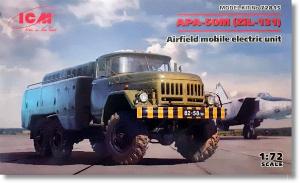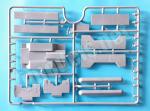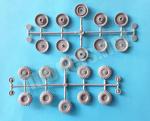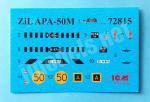
De un vistazo – Quick look
MATERIAL Y PIEZAS
MEDIA & PARTS:
- Plástico inyectado (68 piezas), plástico transparente (7 piezas).
- Injected plastic (68 parts), clear plastic (7 parts).
CALCAS – DECALS:
- Instrumentos del salpicadero, tres juegos de matrículas, marcas del paragolpes, insignias de aeropuerto, numerales y luces traseras. Apariencia fina. Bien impresas sin exceso de soporte.
- Dashboard gauges, three sets of plates, bumper and airport markings, numbers and tail lights. Apparently thin. Well printed without too much carrier film.
OPCIONES – OPTIONS:
- APA-50M. Fuerza Aérea Soviética. 738º Regimiento de Cazas. Zaporiya (Ucrania), 1982.
- APA-50M. Fuerzas Armadas Soviéticas. Unidad desconocida. Años 80.
- APA-50M. Aviación civil de la URSS. Años 80.
- APA-50M. Soviet Air Force. 738th Fighter Aviation Regiment. Zaporozhye (Ukraine), 1982.
- APA-50M. Soviet Armed Forces. Unknown military unit. 1980s.
- APA-50M. Civil aviation of the USSR. 1980s.
INSTRUCCIONES – INSTRUCTIONS:
- Folleto A4 de 8 páginas impresas en color sobre papel satinado. Contiene un sumario histórico y técnico sobre el vehículo, una lista de colores con equivalencias en diferentes gamas de pinturas, un plano numerado de piezas, 10 pasos de montaje y 3 páginas de perfiles. Muy claras.
- 8-page A4 brochure printed in color on satin paper. It shows a historical and technical summary about the vehicle, a list of colors with matches in several paint ranges, a numbered parts plan, 10 assembly stages and 3 pages of profiles. Very clear.
LO MEJOR – THE BEST:
- Muy buen detalle. Montaje sencillo.
- Nicely detailed. Easy build.
LO PEOR – THE WORST:
- Algunas piezas muy delicadas. Puertas cerradas. Ruedas en mitades.
- Some brittle parts. Doors molded closed. Wheels in halves.
VALORACIÓN – CONCLUSION:
- Tiene muy buen detalle y está al alcance de cualquier modelista. La maqueta resulta ideal para una escena aérea, pero también destacará sola. Muy recomendable.
- It has a nice detail and is suitable for any modeller. Ideal for any airport scene but it can be outstanding alone. Eagerly recommended.

La maqueta
ICM ha vuelto a reeditar la serie de camiones militares rusos que en su día heredó de Omega-K, entre los que se encuentra esta versión del ZiL-131. Se trata del APA-50M, un modelo dotado de un generador eléctrico movido por un motor diésel que se emplea en bases y aeropuertos para el mantenimiento eléctrico de los motores, equipos y sistemas a bordo de aviones tanto civiles como militares. Todos los controles del generador se encontraban en la cabina del vehículo.
El molde lleva muchos años rodando por el mercado en varias versiones (camión de carga, puesto de mando, etc.), pero no teníamos esta versión con generador y, por tanto, se trata de una maqueta parcialmente renovada: chasis antiguo con carga novedosa. También es nuevo en esta edición la caja y las nuevas instrucciones que ICM le ha dado para actualizarla. La maqueta se presenta en tres bastidores de piezas grises, un bastidor transparente, las calcas y las instrucciones. El contenido viene dentro de la habitual bolsa con un práctico cierre engomado que permite abrirla sin romperla. Dos de los bastidores contienen el vehículo base y el tercero las piezas para montar la unidad eléctrica de la caja de transporte.
El moldeado de las piezas es correcto. Algunas son muy delicadas por su finura y habrá que tener cuidado al cortarlas de los bastidores y al manipularlas. Pese a que el molde tiene ya veinte años a las espaldas, aún resulta equiparable a los de maquetas más actuales, carece de marcas visibles y sólo hay que limpiar ligeros restos de rebabas y pequeños puntos de salida del eyector en algunas piezas. Comparada con el Ural 4320, otra antigua maqueta de Omega-K que comercializa ICM, los cristales de la cabina son bastante mejores y prácticos para pintar.
Bastidor, motor y transmisión
El bastidor está moldeado en una pieza unida al radiador y los pescantes frontales, que muestran un fino relieve antideslizante. Los soportes de los pescantes laterales de la cabina deben ser eliminados en esta versión. El enganche de remolque posterior está separado en una pieza y hay otras dos para los delanteros.
El motor sólo está reproducido en su mitad inferior con un detalle más sugerente que acertado. La caja de cambios va unida en la misma pieza. El tubo de escape está formado por tres conductos muy finos y con formas diferentes más una pieza para el silenciador. Según las instrucciones debemos colocarlo una vez montado el chasis. Hay también una caja de cambios auxiliar y tres depósitos de aire comprimido, todos ellos de una pieza.
El árbol de la transmisión tiene tres secciones con las juntas cardan bien moldeadas. El eje delantero está unido al diferencial. Los demás ejes tienen la parte superior del diferencial separada, lo que permite pegar las secciones del árbol más cómodamente. La barra de la dirección es una pieza muy fina y va añadida por debajo de los extremos del eje delantero, que están moldeados con las ballestas.
Suspensión y ruedas
En la suspensión vemos cuatro ballestas unidas a los extremos de los ejes, a su vez pegados sobre los palieres. Las ballestas sólo tienen detalle sobre sus lados externos, por detrás son planas. Entre los ejes traseros hay que introducir una fina barra de torsión.
Las ruedas están fabricadas en mitades con el buje separado y acertadamente detallado con el freno de tambor. El dibujo de los neumáticos es suficiente y nítido para lo que se puede representar en plástico en esta escala. El vehículo carece de rueda de repuesto, lo mismo que el real.
Cabina
La cabina junto con el capó y los guardabarros delanteros son de una pieza. El interior viene aparte y está unido a los paneles internos de los huecos de las ruedas. Esta pieza contiene también el mamparo delantero detallado con los pedales y unos asientos demasiado planos pero aceptables. El salpicadero está detallado en relieve, pero hay una calca para los indicadores del panel. También encontramos el volante, la columna de dirección la palanca de marchas y la palanca de cambio de tracción, aunque falta el freno de mano.
El detalle externo de la cabina es muy bueno. Muestra los paneles del techo, las molduras del capó y los guardabarros correctamente reproducidos y una nítida parrilla delantera.. Las puertas, sin embargo, vienen cerradas.
El detalle externo comprende no pocas piezas. En primer lugar, los cristales son bastante finos y poseen una buena transparencia. Van añadidos desde el exterior, lo que resulta bastante práctico al pintar. Hay tres desventajas, nimias si se quiere, con estos cristales. Una es que las pequeñas ventanillas laterales de ventilación no poseen sus propio cristal, con lo que el transparente queda superpuesto al perfil de la ventanilla. La segunda, más de picajoso que otra cosa, es que el parabrisas delantero es demasiado plano y no tiene las formas redondeadas frontales que se aprecian en el camión real. La tercera parece más importante, y es la ausencia de los limpiaparabrisas.
Además de esto, hay que pegar las faldillas antibarro, los retrovisores, el extintor, un foco auxiliar, las lentes transparentes de los faros y sus rejillas protectoras. Las rejillas son bastante aceptables en grosor para este medio, siendo su único defecto el de tener demasiada profundidad.
La sección central del pescante frontal y el paragolpes se añaden en esta fase del montaje para completar el conjunto.
Generador
La caja del generador G AO-36 que lleva este camión se compone de un suelo, dos laterales y una parte trasera, mientras que el techo está separado en cinco piezas, las dos laterales en forma de pasillo con el suelo texturizado que sirven de apoyo para trabajar en los motores y fuselaje del avión.
La cara delantera muestra lo que parece una toma de combustible para el motor diésel interno que mueve el generador. La posterior está detallada con las luces traseras, que vienen representadas en calcas, diminutas rejillas de ventilación y varios accesos con los pestillos nítidos. Y lo mismo ocurre con los lados, pero en este caso los paneles son más amplios. El techo tiene una sección sobreelevada cuyos lados muestran también rejillas bien definidas.
Como detalles externos no queda sino añadir las barandillas del techo, que son muy finas y quebradizas, el escape del motor diésel, y un par de peldaños de acceso al techo en la cara delantera izquierda.
Calcas
La pequeña hoja contiene los instrumentos del salpicadero, tres juegos de matrículas, marcas del paragolpes, insignias de aeropuerto, numerales y las luces traseras. Los motivos parecen finos, están impresos con suficiente nitidez y sin exceso de soporte.
Instrucciones
Se presentan en un folleto de tamaño A4 con ocho páginas impresas en color sobre papel satinado. Contiene un sumario histórico y técnico sobre el vehículo, una lista de colores con equivalencias en pinturas de ICM, Revell y Tamiya, un plano numerado de piezas, diez pasos de montaje y tres páginas de perfiles. Las secuencias de montaje son muy claras.
Los perfiles nos muestran dos versiones militares soviéticas situadas en los años 80, una de ellas con la cabina de un color ligeramente diferente, y una civil de los mismos años. Los que no deseen estas versiones tan uniformes, pueden buscar este vehículo con camuflaje en la web como los que he encontrado sin demasiado esfuerzo.
Valoración
Este APA-50M parece una maqueta ideal para situarla en múltiples escenas, pero también lucirá por sí sola en cualquier vitrina. Sorprende lo actual que parece este molde sin serlo, porque el detalle es realmente notable y el montaje aparenta gran sencillez.
Lo recomiendo a los seguidores de los vehículos y aviones civiles o militares de esta escala.◊

The kit
ICM have once again reissued the series of Russian military trucks they once inherited from Omega-K, among which is this version of the ZiL-131. This is an APA-50M, a variant equipped with an electric generator powered by a diesel engine that is used in bases and airports for the electrical maintenance of engines, equipment and systems on board of both civil and military aircraft. All generator controls were located in the vehicle cabin.
The tooling has been on the market in various versions (cargo truck, command post, etc.) for many years but we did not have this version with a generator and, therefore, it is a partially renovated kit: old chassis with new load. Also new to this edition is the box and the new instructions. The kit comes in three frames of grey parts, a clear frame, the decals and the instructions. The content comes inside the usual bag with a practical self-sealing flap. Two of the frames contain the base vehicle and the third parts to assemble the electrical unit of the cargo bed.
Parts are correctly molded. Some are very delicate and brittle, and care is needed to take them out of the frames and when handling them. Although the tooling is already twenty years old, it is still comparable to what we can find today. It lacks visible marks and there is some slight flash and small ejector peeps on a few pieces, that’s all. Side to side with the Ural 4320, another Omega-K kit reboxed by ICM, the cab windows are much thinner and convenient to paint.
Frame, engine and transmission
The frame is molded in one piece joined to the radiator and the front running board, which shows a fine non-slip raised detail. The cab running board brackets must be trimmed in this version. The rear tow hitch is separated in one piece and there are two others for the front tow hooks.
The engine is only reproduced in the lower half with a detail that is more suggestive than accurate. The gearbox is joined in the same piece. The exhaust system is made up of three very thin pipes with different shapes plus a piece for the muffler. According to the instructions, it is attached once the chassis is finished. There is also an auxiliary gearbox and three compressed air tanks, all of which are one piece.
The driveshaft has three sections with sharply molded cardan joints. The front axle is one piece with the differential. The other axles have the upper part of the differential separated, which allows the shaft to be glued more easily. The steering bar is a very thin piece added below the front axle.
Suspension and wheels
The suspension comprise four leaf springs attached to the ends of the axles, which are in turn glued to the bearings. The springs only have detail on their external sides and they are flat on the back. A thin torsion bar is inserted between the rear axles.
The wheels are made in halves with the hub separated and accurately detailed with the drum brake. The tire tread is enough for what can be molded in plastic at this scale. The vehicle lacks a spare wheel, as the real one.
Cab
The cab along with the hood and front fenders are one piece. The interior comes separately and is joined to the insides of the wheel arches. This piece also contains the front bulkhead molded with the pedals and some seats that are too flat but acceptable. The dashboard shows raised detailed, but there is a decal for the gauges. We also find the steering wheel, the steering column, the gear lever and the traction shift lever, although the handbrake is missing.
The cab external surface is really fine. It shows correctly reproduced roof panels, hood and fender moldings and a sharp front grille. The doors, however, come closed.
External detail includes many pieces. First of all, the window panels are quite thin and transparent. They are added from the outside, which is quite practical for painting. There are three disadvantages, minor if you want, with these pieces. One is that the small side quarter glasses do not have their own separate pieces and the window is simply fitted on. The second, just to be nitpicking, is that the front windshield is too flat and does not have the rounded front shapes that can be seen on the real truck. The third seems more important, and it is the lack of windshield wipers.
In addition to this, you must glue the mudflaps, the mirrors, the fire extinguisher, an auxiliary spotlight, the clear headlight lenses and the cages. The cages are quite acceptable in thickness for this media, their only shortcoming being that they are too deep.
The center section of the front running board and bumper are added at this stage to finish off the cab assembly.
Generator
The G AO-36 generator box carried by this truck is made up of a floor, two sides, a front and a rear panel, while the roof is separated in five pieces. Two of them are used as a kind of scaffold molded with a non-slip floor to access the engines and fuselage of a plane.
The front panel shows what seems the fuel filler cap for the internal diesel engine that powers the generator. The rear panel is detailed with the tail lights, which are rendered in decals, tiny ventilation louvres and several hinged panels with defined latches. The same happens with the sides, but in this case the panels are wider. The roof has a raised section with sides also showing nice ventilation louvres.
Once this is finished, the only things to add are the brittle roof rails, the diesel engine exhaust, and a pair of steps on the front left side.
Decals
The small decal sheet contains dashboard gauges, three sets of plates, bumper and airport markings, numbers and tail lights. Decals look thin, sharp and have no surplus carrier film.
Instructions
They come in an A4 8-page booklet printed in color on glossy paper. It contains a historical and technical summary about the vehicle, a list of colors with paint matches from ICM, Revell and Tamiya, a numbered parts plan, ten assembly steps and three pages of profiles. Assembly sequences are very clear.
The profiles show us two Soviet military versions located in the 1980s, one of them with the cabin in a slightly different color, and a civilian truck from the same years. Those who do not feel attracted by these finishes can search for a camouflaged example on the web like the ones I have found without too much effort.
Conclusion
This APA-50M is an ideal kit to be placed in multiple scenes, but it will also look fine on its own in any shelf. It is surprising how updated this tooling looks after around 20 years as detail is truly remarkable and assembly should not be difficult for any modeller. Definitely, I recommend it to fans of 1/72 civil / military vehicles and aircraft.◊
Publicado – Published: 10 / 2023
©www.jmodels.net












Debe estar conectado para enviar un comentario.